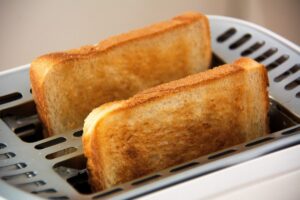 Books. Ceiling fans. Your toaster. These are some of the oddball items that, believe it or not, need regular cleaning. But the question is: How often should you clean that?
Books. Ceiling fans. Your toaster. These are some of the oddball items that, believe it or not, need regular cleaning. But the question is: How often should you clean that?
Here are tips on timing and easy cleaning tricks for 12 things around the house.
Books, 3 to 6 months
Believe it or not, the books on your shelves need cleaning. If you don’t, the pages can discolour and deteriorate. A good rule of thumb is to tackle this chore at the start of each season. Dust spines and tops, flip through the pages and rotate any stacked books to minimize warping.
Bedding, once a week
Sure, we clean our sheets, but this is one many do not do often enough, especially since sheets will accumulate a surprising amount of dead skin cells, mites and bacteria. Wash your sheets in hot water, if the fabric can take it. It’s also a good idea to vacuum your mattress every two weeks to keep dust mites down.
Pillows, 3 to 6 months
Washing your pillowcase is not enough; your pillow occasionally needs to be cleaned as well. Most pillows can go in the washing machine and should be cleaned seasonally to get rid of mould, bacteria and odours. Just be sure to follow your pillows’ washing instructions. More pillow cleaning tips.
 Toaster, weekly
Toaster, weekly
Regular cleaning of small appliances like your toaster can greatly expand their lifespan. How often you should clean your toaster depends on how often you use it; for a toaster that sees daily use, clean it once a week. Remove and empty the crumb drawer (did you know there was one?), then tip your toaster upside down and shake out any remaining crumbs. It’s easiest to do this over the sink, just collect the crumbs after for your green bin. Then give the exterior a wipe down.
MORE: Cleaning your coffeemaker and cleaning your kettle
Ceiling fan, weekly
If your fan runs continuously, which it should for better air circulation, it’s hard to see the accumulated dust and dirt. But even a moving fan will pick up dust from the air. A simple way to clean it is to make it part of your weekly vacuuming routine. Another option is to stand on a step stool, slide an old pillowcase over a blade, press both hands against it and slowly slide the case off, capturing the dirt and dust inside the pillowcase. Repeat for each blade, then throw the pillowcase in the laundry.
Laptops & cellphones, weekly
Your phone, keyboard and computer mouse are great places for dust, dirt and bacteria to linger and hide. For keyboards, a can of compressed air will dislodge dust and dirt. Use special electronic cleaning cloths for surfaces, never harsh cleaning sprays. And remember to turn off/unplug before cleaning to protect them from damage.
Sponges, daily & weekly
Sponges soak up a surprising amount of germs and bacteria, some of which can be harmful. If you use a sponge in your kitchen, thoroughly rinse and wring it out after every use, keeping it in an open dish so that it can dry thoroughly. Sponges should be used for no more than two or three weeks and in between should be cleaned at least once a week. One way is to soak it in undiluted vinegar for five minutes, then rinse. Another is to pop it in the dishwasher, but only if you use the “heated dry” setting. Both methods should kill virtually all bacteria.
Light fixtures, weekly
You already know that regularly dusting furniture and ornaments helps keep your home fresh and clean, but how often do you do your light bulbs? Dust can reduce their brightness by 50 per cent or more, according to the U.S. Department of Energy. In most cases, a clean, dry dust cloth is all you need. Exposed bulbs in the kitchen can accumulate grease, so remove those bulbs, clean the light-emitting part only with a dampened cloth and wait until the bulbs are thoroughly dry before reinstalling them.
Drains, weekly & monthly
To help break down accumulated debris, flush your kitchen and bathroom drains once a week with boiling water. Once a month, flush them with a mix of ½ cup vinegar and ½ cup baking soda, plus boiling water. This will help keep odours down.
Sinks, daily
If you haven’t heard this one before, beware: your kitchen sink is likely dirtier than your toilet. With all the food handling our sinks face, it’s not surprising that bacteria can and does contaminate our sinks. Even the bathroom sink is not as clean as you might think: it can accumulate fecal matter from washing your hands after using the toilet. That’s why daily sanitizing is important. Use a disinfectant cleaner to thoroughly wipe the bowl, faucet and taps. While you’re at it, do the counter as well.
MORE: How to clean your faucet aerator
 Makeup brushes, weekly
Makeup brushes, weekly
Did you know that not cleaning your makeup brushes regularly can lead to breakouts? That’s thanks to a buildup of bacteria that can result. Wash them once a week with either a makeup brush cleaner or mild soap, gently massaging the bristles, rinsing thoroughly and squeezing out excess moisture with a clean towel. Let the tips dry over the edge of a counter (not on a towel) so they will both dry in the correct shape and to reduce the risk of mildew.
Towels, sometimes daily
This is another one many don’t do often enough. Kitchen towels and face cloths should be laundered after each use, hand towels every couple of days and bath towels after about three uses, according to experts. This is to both keep down bacteria and avoid musty-smelling towels.
Originally published Feb. 25, 2019.
Got a maintenance task you’re not sure how to do?
Drop us a line at info@allthingshome.ca or message us through Facebook.








